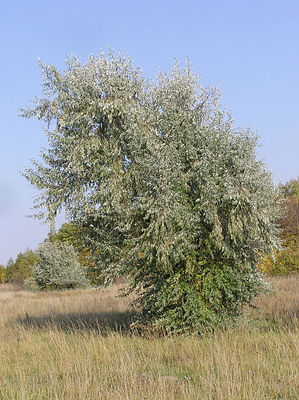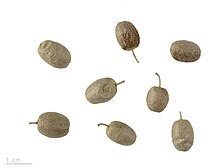Narrow-leaved olive willow
| Narrow-leaved olive willow | ||||||||||||
|---|---|---|---|---|---|---|---|---|---|---|---|---|

Narrow-leaved olive willow ( Elaeagnus angustifolia ) |
||||||||||||
| Systematics | ||||||||||||
|
||||||||||||
| Scientific name | ||||||||||||
| Elaeagnus angustifolia | ||||||||||||
| L. |
The narrow-leaved olive ( Elaeagnus angustifolia ) is a species of the olive family (Elaeagnaceae).
description
Appearance and leaf
The narrow-leaved olive willow is a deciduous, densely branched and thorny shrub or small tree with a mostly wide crown, the stature heights of 2 to 5 meters, rarely reaches up to 7 meters; in exceptional cases also higher. The young twigs and buds are densely covered with silvery shield hairs that look like a silvery, wipeable coating. The twigs and branches have thin, reddish-brown bark and thorny short shoots.
The alternate leaves are arranged in a petiole and a leaf blade. The simple, leathery leaf blade is 4 to 8 centimeters long and narrow-lanceolate with a wedge-shaped blade base and a pointed or bluntly rounded upper end. The upper side of the leaf is gray-green and glabrous and the lower side is silver-gray and densely covered with whitish star hairs ( trichomes ).
blossom
The flowering period extends from May to July. The short-stalked flowers stand individually or in groups of two to four in the leaf axils in the lower area of the branches. The hermaphroditic or purely male flowers are up to 1 centimeter in diameter and four-fold. The four sepals are light yellow on the inside, silvery hairy on the outside and smell pleasantly of leather. Petals are missing.
fruit
The light yellow fruits are oval to cylindrical pseudo berries with a length of 1 to 2 centimeters. These have a very aromatic taste and are edible. The fruit ripening begins in July. In Central Europe, however, fruits are rarely produced.
Chromosome number
The number of chromosomes is 2n = 28.
ecology
The narrow-leaved oil willow lives in symbiosis (the so-called actinorrhiza ) with Frankia bacteria that bind nitrogen in the air .
The pollination is usually by bees . After the anthesis , the upper part of the calyx tube dies, the lower part surrounds the growing ovary . The inner parts of the corolla tube become rock-hard, the outer mealy-fleshy, so that the fruit resembles a stone fruit .
Occurrence
The narrow-leaved olive willow is native to central Asia . It was introduced to the Mediterranean region in the 17th century and is widespread there. In Central Europe , the narrow-leaved olive willow is often cultivated as an ornamental wood and has become wild in places.
Elaeagnus angustifolia was introduced to North America around 1800 and became wild in places, which means that, as in Europe, this species is also considered a neophyte there .
Frequent locations are riparian wood by lakes and rivers, forest fringes, bushes in a sunny location on loose, slightly moist soils .
use
The narrow-leaved olive willow tolerates shaping pruning and then forms very dense hedges. It is so ideal as a windbreak. It is also planted for embankment reinforcement and greening and as a slip inhibitor on sand dunes. It is not only considered to be less sensitive to air pollution, but also tolerates quite high concentrations of salts of all kinds in the soil. In particular, it is resistant to road salt . However, it does not tolerate severe frosts, especially in late spring.
The flowers are a productive costume for bees and other hymenoptera .
In the Orient , the dried, nut-like tasting fruits are consumed as food . In cultivated varieties, the fruits are 2 centimeters long and 1 centimeter thick. They contain 10–55% protein and are rich in glucose , fructose , potassium and phosphorus .
An experimental clinical study has shown that the administration of E. angustifolia extract can reduce symptoms of osteoarthritis to a comparable extent as with standard therapy.
The fragrances of the flowers are used in the perfume industry .
The amber colored honey is very aromatic.
Common names
The other common German-language names exist or existed for the narrow-leaved olive tree: Bohemian olive tree ( Silesia ), olive tree ( Silesia ), olive Zeidel, Paradiesbaum and Rächä Weyd ( Transylvania ).
Cultural meaning
The fruits are also known as whitebeam ; As a decoration for the Persian New Year festival Nouruz , as "Senjed" they belong to the seven components of the traditional New Year table Haft Sin .
swell
- Dietmar Aichele, Renate Aichele, Heinz-Werner Schwegler: Kosmos nature guides. Which tree is that Trees, bushes, ornamental trees. 24th edition, Franckh-Kosmos, Stuttgart 1992, ISBN 3-440-06570-7 .
- Peter A. Schmidt, Ulrich Hecker: Pocket dictionary of trees. Quelle & Meyer, 2009, ISBN 978-3-494-01448-7 .
- Lutz Roth, Kurt Kormann: Scented plants, plant scents. econmed-Verlag, 1996, ISBN 3-609-65140-7 .
Individual evidence
- ^ Erich Oberdorfer : Plant-sociological excursion flora for Germany and neighboring areas. 8th edition. Verlag Eugen Ulmer, Stuttgart 2001, ISBN 3-8001-3131-5 . Page 662.
- ↑ David R. Benson: Ecology - Elaeagnaceae Frankia of the University of Connecticut.
- ↑ Data sheet from Fire Effects Information System = FEIS of the USDA Forest Service .
- ↑ Yunes Panahi, Gholam Hossein Alishiri, Noushin Bayat, Seyed Morteza Hosseini, Amirhossein Sahebkar: Efficacy of Elaeagnus Angustifolia extract in the treatment of knee osteoarthritis: a randomized controlled trial . In: EXCLI Journal . tape 15 , March 2, 2016, ISSN 1611-2156 , p. 203–210 , doi : 10.17179 / excli2015-639 , PMID 27330526 , PMC 4908661 (free full text).
- ^ Georg August Pritzel , Carl Jessen : The German folk names of plants. New contribution to the German linguistic treasure. Philipp Cohen, Hannover 1882, page 138. ( online ).
- ↑ Toumaj Khakpour: How the Persian New Year is celebrated. In: derstandard.at. March 20, 2013, accessed December 21, 2016 .
Web links
- Narrow-leaved olive willow . In: BiolFlor, the database of biological-ecological characteristics of the flora of Germany.
- Elaeagnus angustifolia L., narrow-leaved olive willow. In: FloraWeb.de.
- Profile and distribution map for Bavaria . In: Botanical Information Hub of Bavaria .
- Thomas Meyer: Data sheet with identification key and photos at Flora-de: Flora von Deutschland (old name of the website: Flowers in Swabia )






